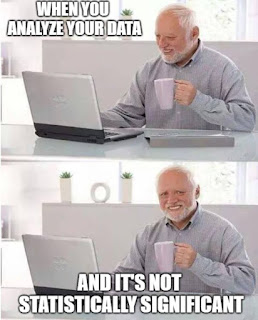Pass/Fail... the Student's t-test
Trying to pull together statistics for data from the entire class on the due date is a poor life choice. It's arguably one of the poorest life choices you can make as a Course 20-- especially when you haven't started making figures or decided what your "take-home message" for each results page should be. It's THE WORST POSSIBLE CHOICE when you realize at 5PM on the due date that you can't even open a different group's files. Thankfully, the shared MIT student/procrastinator experience allows you to frantically message classmates and get instant help/responses when needed.
It's difficult to write a data summary when you have a vague idea what your data should show, but your data flip flops between consistency and inconsistency with expectations. Going through the Mod1 Data Summary, I've learned that the greater the N, the more likely you are to find significance consistent with your expectations. Overall, this was a fun module, though just a note for future students, make sure you get class data for analysis well before you start data analysis, much less writing your Data Summary.
It's difficult to write a data summary when you have a vague idea what your data should show, but your data flip flops between consistency and inconsistency with expectations. Going through the Mod1 Data Summary, I've learned that the greater the N, the more likely you are to find significance consistent with your expectations. Overall, this was a fun module, though just a note for future students, make sure you get class data for analysis well before you start data analysis, much less writing your Data Summary.


Comments
Post a Comment